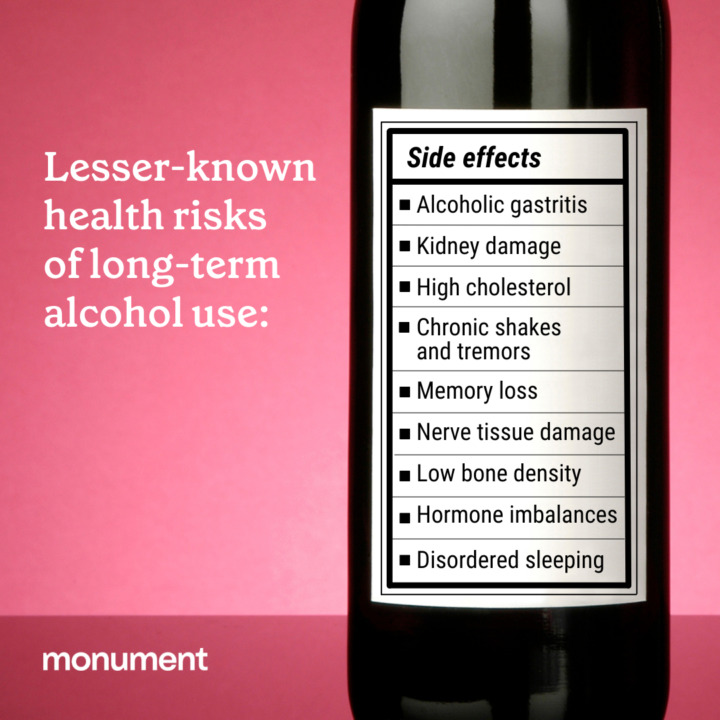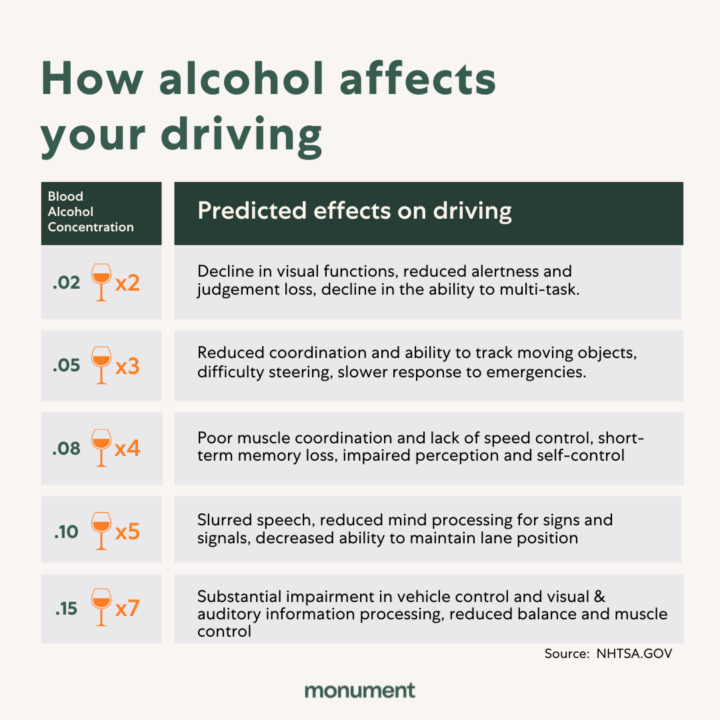Most people think of blood alcohol content (BAC) as it relates to breathalyzer tests and the legal limit for driving, which is 0.08%. But what does BAC mean exactly, and why is that percentage important? Learning more about BAC can help you better understand your body and set safer limits with alcohol.
Below, we will dive deeper into the meaning of BAC, give a brief overview of how different BAC levels can affect the body, and explore what factors impact BAC.
What is Blood Alcohol Content (BAC)?
Blood alcohol content, also known as ‘blood alcohol level’ or ‘blood alcohol concentration,’ measures the percentage of alcohol present in the bloodstream after consuming alcohol. When alcohol enters the body it enters the stomach and small intestine and then gets absorbed directly into the bloodstream. Alcohol is a toxin, and will stay in the bloodstream until it’s eventually filtered out by the liver. However, the liver can only metabolize approximately one standard drink per hour. Whatever alcohol has not been metabolized continues to circulate in your bloodstream.
Your overall BAC will depend on the amount you drink, how fast you drink, and how much food you have in your stomach. Other factors such as your weight, sex, and age can also play a role.
How Much Does One Drink Raise Your BAC?
Every individual processes alcohol differently, but on average, a standard drink will increase BAC somewhere between 0.02 to 0.04 points.
Weight and body mass also affect how the body metabolizes alcohol and how quickly BAC rises. For example, a 100 pound man would typically have a BAC of 0.04 after one drink, whereas a 200 pound man might have a BAC of 0.02 after having the same drink. Time also plays a factor. Your body’s metabolizing process can reduce your BAC level by approximately 0.015 per hour. Therefore, increasing time between drinks and consuming drinks slowly can decrease your overall BAC.
Speaking with a physician is a great way to learn more about how alcohol affects your body specifically, and how you can build healthier habits by safely tapering your drinking.
Effects of High BAC Levels
As blood alcohol concentration increases, so do the effects a person feels from drinking. Even relatively small increases in BAC can decrease motor coordination, cloud judgment, and make a person begin to feel ill. The effects of high levels of BAC (typically above 0.15%) are even more extreme. These include:
- Partial or total memory gaps (blackouts)
- Loss of consciousness
- Vomiting and nausea
- Impaired vision and speech
- Increased heart rate
- In extreme cases, death
What many people don’t realize is that BAC can continue to rise even after a person stops drinking or is unconscious. Even though a person may finish an alcoholic drink in just a few minutes, it doesn’t mean that the body can process it that fast. As mentioned above, alcohol is held in the stomach and small intestine, and then gets slowly absorbed into the bloodstream. This can cause your BAC levels to rise steadily over time, even after you stop drinking.

BAC Levels Explained: Stages of Drinking
While everyone’s response to various BAC levels is different depending on various factors like their sex and weight, there are common patterns that are observed at each level. Below we will breakdown the symptoms that characterize each stage.
BAC 0 to 0.03
During this stage, the average individual will appear ‘normal’, though subtle effects may be detectable with special tests.
BAC 0.03 to 0.05
At this stage, the euphoria that some people seek when they first start to drink can become noticeable. Feelings of relaxation, talkativeness, and decreased inhibition can present themselves. The ability to concentrate can also become impaired.
BAC 0.06 to 0.08
Once BAC increases above 0.06, there can be significant impairments to an individual’s reasoning, depth perception, light sensitivity, and peripheral vision. Emotional numbness and reduced pain sensitivity are also common.
BAC 0.08 to 0.19
This is the point at which a person is over the legal limit for driving and can be liable to public intoxication charges. Common patterns include risky behavior, boisterousness, and the possibility of nausea and vomiting. Reflexes, reaction time, motor control, and speech can become impaired.
BAC 0.20 to 0.29
This stage is characterized by nausea, vomiting, mood swings, feelings of anger or sadness, confusion, impaired sensations, and decreased libido. Severe motor impairment, loss of consciousness, and memory blackout can occur.
BAC 0.30
At this level, the central nervous system becomes extremely suppressed. This is because alcohol is a depressant. Severe behaviors and impairments begin to manifest: such as loss of understanding and lapses of consciousness.
BAC 0.40
At this stage, the central nervous system can start to shut down. Breathing and heart rate can become so impaired that most people lose consciousness, and there is a greater risk of coma or death.
It’s important to note that for each of these categories, the typical effects will vary depending on one’s alcohol tolerance. As someone drinks more frequently, their body can learn to compensate for the intoxicating effects of alcohol. This is why some people find over time that they require more alcohol in order to feel the same effects they once did.
That said, just because tolerance can affect the way someone feels after drinking, it does not affect their BAC. For example, the BAC level that causes an individual to blackout will remain roughly the same throughout their lifetime, no matter their drinking habits. Developing a tolerance can be especially dangerous because it can cause many people to underestimate how their consumption is affecting their BAC.

Factors That Impact BAC
There are several factors that influence someone’s BAC besides the amount of alcohol they consume. Here are some of the most common ones to be aware of.
Body Size and Composition
Simply put, the larger a person’s build, the longer it will take for their BAC to rise. This is because alcohol has more space to dilute throughout the body and the bloodstream. Body composition can also play a role. If two people weigh the same but one has more body fat, they will likely experience a higher BAC level than the person with more muscle. This is because body fat is less efficient at absorbing alcohol from the blood than muscle.
Testosterone and Estrogen Levels
People with higher levels of testosterone tend to have more muscle mass than people with high levels of estrogen. Since muscle contains more blood than fat, the alcohol will dilute more easily and cause BAC to remain lower. Testosterone also affects how much water is in the body. This difference changes how the body dilutes alcohol and, in turn, lowers BAC.
Higher levels of testosterone can also mean higher levels of alcohol dehydrogenase, which is an enzyme that helps break down alcohol and lower your overall BAC.
Additional Medications in the System
Many medications can have interactions with alcohol that impact BAC. This applies even to medications that are prescribed. As always, it is best to ask your prescribing doctor about any risk of interactions in order to ensure your safety.
Amount of Food in the Stomach
Having food in your stomach does in fact slow down the effects of alcohol on the body and mind. While the common conception that food absorbs alcohol isn’t entirely accurate, (food serves as more of a blocker than an absorber) it does reduce the risk of BAC rising too rapidly.
Slowed Metabolism
Your metabolism dictates how fast your liver is able to process alcohol. There are various factors that can slow down your metabolism, including lack of sleep, lack of exercise, and high stress and anxiety. When your metabolism is slowed, your BAC will remain higher for longer.
Menstrual Cycle
Due to changes in hormone levels, a person experiencing menstruation will metabolize alcohol more slowly and have a higher BAC than someone who isn’t menstruating.
Type of Alcoholic Beverage or Mixer
Drinks that contain high levels of sugar (like fruit juice) will actually slow the rise in BAC. This is because sugar requires digestion, and that can delay the time it takes for alcohol to be absorbed from the stomach into the bloodstream. Oppositely, carbonated drinks will actually cause BAC to rise more rapidly because any type of carbonation speeds up absorption.
Dangers of High BAC Levels
There are many dangers of high BAC levels. A BAC between 0.16-0.30% is considered to severely impair speech, memory, coordination, reaction time, and balance. Because of this, physical accidents and injuries become dramatically more likely. Decision-making abilities also become impaired, which can lead to unwanted consequences, such as financial or relationship strains.
Even higher levels of BAC (0.31-0.45%) can lead to an alcohol overdose, also known as ‘alcohol poisoning.’ This happens when there is so much alcohol in the bloodstream that the body’s basic functioning shuts down, and can result in death. The warning signs of overdose include:
- Mental confusion
- Difficulty remaining conscious
- Vomiting
- Seizures
- Slowed or irregular breathing
- Slow heart rate
- Clammy skin
- Dulled responses (not having a gag reflex, for example)
- Extremely low body temperature
- Blue skin or paleness
Knowledge is power, and learning more about this topic today is an incredible step. If you’re concerned about your drinking habits, you have a lot of resources at your fingertips. At Monument, we offer therapist-moderated support groups and community forums, as well as treatment options like alcohol therapy and medication to stop drinking. Remember, you are never alone in this journey, and a healthier relationship with alcohol is within reach.
Sources:
- FirstStepServicesLLC. Blood Alcohol Content (BAC) Calculator | First Step Services LLC https://firststepnc.com/blood-alcohol-content-calculator/
- The University of Notre Dame. Blood Alcohol Concentration https://mcwell.nd.edu/your-well-being/physical-well-being/alcohol/blood-alcohol-concentration/
- The University of Texas at Austin University Health Services Blood Alcohol Concentration(BAC) https://healthyhorns.utexas.edu/bac.html
- Gambone Law. Does your alcohol tolerance determine your blood alcohol level? – Gambone Law https://gambonelaw.com/does-your-alcohol-tolerance-determine-your-blood-alcohol-level/
- Verywellmind. Average Blood Alcohol Content in Men by Weight https://www.verywellmind.com/bac-and-drink-conversions-for-men-by-weight-22481
- National Institue on Alcohol Abuse and Alcoholism. Understanding the Dangers of Alcohol Overdose https://www.niaaa.nih.gov/publications/brochures-and-fact-sheets/understanding-dangers-of-alcohol-overdose
